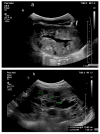Imaging Diagnosis of Major Kidney and Urinary Tract Disorders in Children
- PMID: 40282987
- PMCID: PMC12028883
- DOI: 10.3390/medicina61040696
Imaging Diagnosis of Major Kidney and Urinary Tract Disorders in Children
Abstract
Background and Objectives: Diagnostic imaging is essential for evaluating urinary tract disorders, offering critical insights into renal pathology. This review examines the strengths, limitations, and clinical applications of various imaging modalities, with a focus on pediatric populations. Materials and Methods: A narrative review was conducted, synthesizing current literature on ultrasound (US), computed tomography (CT), magnetic resonance imaging (MRI), nuclear medicine, and voiding cystourethrography (VCUG). Relevant studies were selected based on diagnostic accuracy, clinical utility, and safety considerations. Results: US is the preferred first-line imaging due to its safety, accessibility, and cost-effectiveness. CT excels in detecting renal calculi, trauma, and malignancies but is limited by radiation exposure. MRI offers superior soft tissue contrast without radiation but is costly and often requires sedation. Nuclear medicine evaluates renal function and scarring, while VCUG remains the gold standard for diagnosing vesicoureteral reflux and posterior urethral valves. Conclusions: Imaging modalities are vital for diagnosing and managing urinary tract disorders, with selection based on clinical needs, patient age, and safety. Ultrasound is the primary choice for its non-invasiveness and cost-effectiveness, while CT, MRI, nuclear medicine, and VCUG provide essential structural and functional insights. A balanced approach ensures accuracy while minimizing patient risk, especially in pediatrics.
Keywords: computed tomography (CT); magnetic resonance imaging (MRI); nuclear medicine; ultrasound (US); voiding cystourethrography (VCUG).
Conflict of interest statement
The authors declare no conflict of interest.
Figures




























Similar articles
-
Pediatric urologic imaging.Urol Clin North Am. 2006 Aug;33(3):409-23. doi: 10.1016/j.ucl.2006.03.009. Urol Clin North Am. 2006. PMID: 16829274 Review.
-
Pediatric urologic advanced imaging: techniques and applications.Urol Clin North Am. 2010 May;37(2):307-18. doi: 10.1016/j.ucl.2010.03.007. Urol Clin North Am. 2010. PMID: 20569808 Review.
-
Morphologic Urologic Imaging.Urol Clin North Am. 2025 Feb;52(1):1-12. doi: 10.1016/j.ucl.2024.07.003. Epub 2024 Aug 8. Urol Clin North Am. 2025. PMID: 39537296 Review.
-
Imaging of the Pediatric Urinary System.Radiol Clin North Am. 2017 Mar;55(2):337-357. doi: 10.1016/j.rcl.2016.10.010. Epub 2016 Dec 24. Radiol Clin North Am. 2017. PMID: 28126219 Review.
-
State-of-the-Art Renal Imaging in Children.Pediatrics. 2020 Feb;145(2):e20190829. doi: 10.1542/peds.2019-0829. Epub 2020 Jan 8. Pediatrics. 2020. PMID: 31915193 Free PMC article.
References
-
- Emma F., Goldstein S.L., Bagga A., Bates C.M., Shroff R., editors. Pediatric Nephrology. 8th ed. Springer; Cham, Switzerland: 2022. Diagnostic imaging in pediatric nephrology; pp. 173–211.
-
- Kher K., Schnaper H.W., Greenbaum L.A. Clinical Pediatric Nephrology. 3rd ed. CRC Press; Boca Raton, FL, USA: 2017. Diagnostic imaging of the urinary tract; pp. 87–103.
Publication types
MeSH terms
LinkOut - more resources
Full Text Sources
Medical

